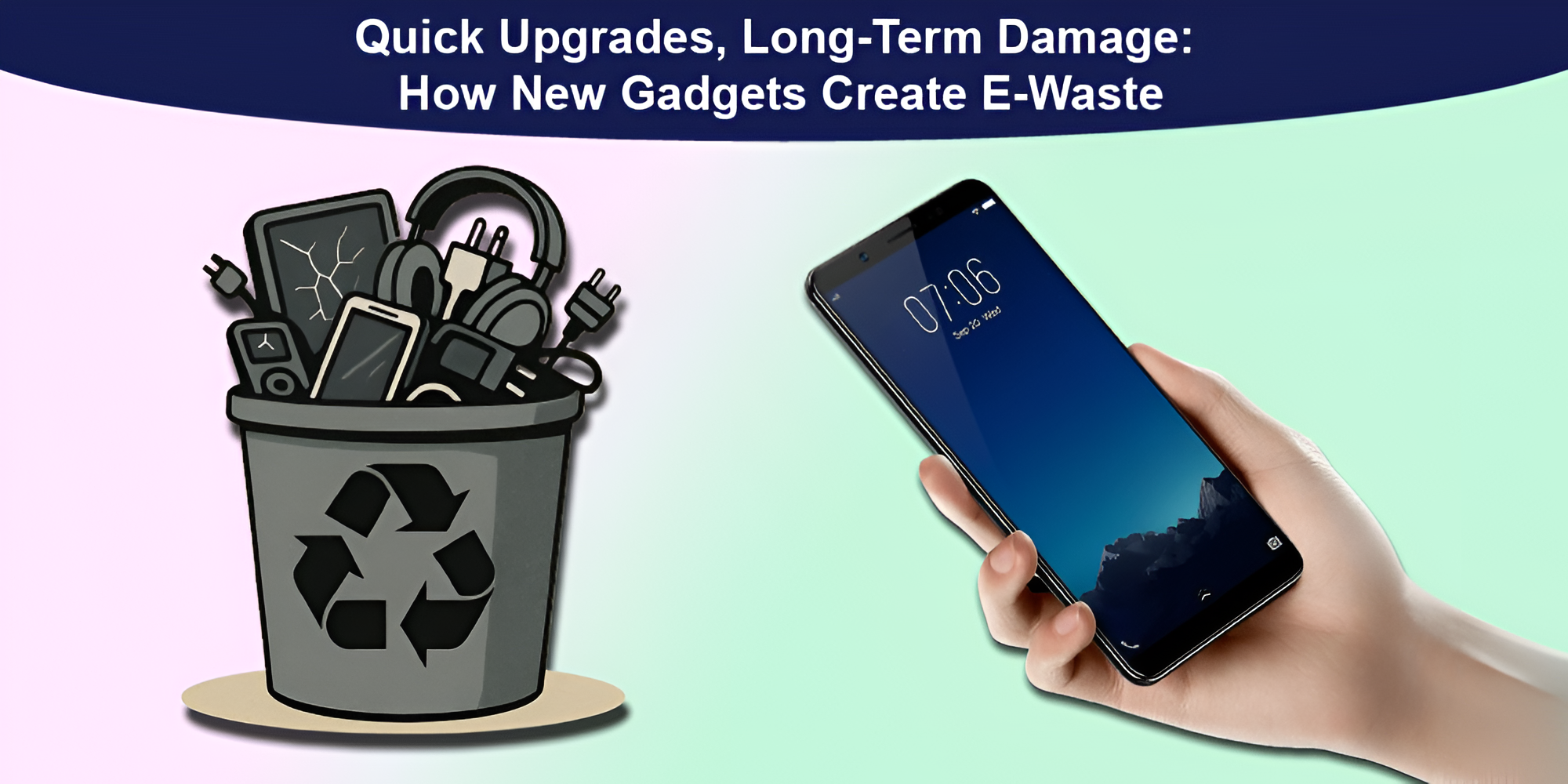Understanding the E-Waste Problem
In this fast-moving world, the exigency for quick upgrades in technology is at an all-time high. Every year, millions of people purchase the latest phones, laptops, and smart devices to replace them shortly thereafter. This policy of mountaineer replacement causes the dangerous rise of e-waste, which is ecologically damaging in the long term. While these newer gadgets come with better features, they ironically compromise the goal of sustainability. The blog will discuss exactly how fast upgrades contribute to e-waste, why it is of a serious concern, and how our purchasing behavior creates long-term damage to our planet.
The Rise of Quick Upgrades in Tech Culture
This digital way of life encourages quick upgrades more than it ever has. Smartphone companies release new models every year, coaxing users to stop using their already working devices. These quick upgrades create e-waste because users want to be in sync with the marketing trends on technology. These endless upgrades entail the disposal of millions of gadgets. With every hour passing, when a consumer replaces a particular product with something else, the consumer is contributing towards the ever-growing global e-waste, which optimizes long-term damage to the ecosystem. Choosing new models unnecessarily is considered to be the biggest cause of this global issue.
E-Waste: A Silent Environmental Threat
E-waste is a modern issue with discarded products such as phones, televisions, and laptops. It wastes space, and with quick upgrades, we choose to discard e-waste. Their very presence there could lead to soil and water contamination from dangerous chemicals, resulting in long-term damage. Only a fraction of e-waste gets recycled in a proper manner. The rest they pollute, silently but surely, deep the damage. The fast pace of quick upgrading shortens the lifespan of a device and deepens the environmental crisis. It is vital to understand how quick upgrades create e-waste and pose a threat to sustainable living.
-
E-waste includes discarded electronics like phones and laptops.
-
Quick upgrades create e-waste, adding millions of devices to landfills.
-
E-waste releases toxic chemicals (like lead and mercury) into soil and water.
-
Only a small percentage of e-waste is properly recycled.
-
Improper disposal causes long-term damage to the environment and human health.
-
Quick upgrades shorten device life and increase pollution.
-
Awareness is key to reducing e-waste and encouraging sustainable habits.
The Impact of Manufacturing and Disposal
Every new device in the market requires energy, rare earth materials, and water during its production. Thus, when quick upgrades mean e-waste, old gadgets might be one-half of the story; the other half would be the resources wasted in making new ones. Manufacturing also leads to the emission of greenhouse gases that cause climate change: the improper disposal of un-approved gadgets adds landfill and poisonous spread. As consumers chose to grab quick upgrades, they unintentionally support blemishing on practices that would ensure long-term damage. Curtailing the demand for constant upgrades is basically slowing down the emergence of e-waste and saving resources.
Why Consumers Are Choosing Quick Upgrades
Many users basically upgrade their gadgets, or like some say, change for good, for more and better functions while older versions, retort some, don’t have any. Advertising pressure and market trends are mainly responsible for this. Rapid changes, with an e-waste perspective, dispose of older gadgets which are still in perfectly working condition. The cycle is thus continued by loyalty programs, trade-ins, and fear of missing out-a consumeristic culture that has fast-tracked electronic waste and environmental harm. It is useful for the consumer to rethink the need for upgrades in order for e-waste to be confronted better.
Developing Countries and the E-Waste Burden
Typically, what happens is that rich countries export e-waste to poor countries, where disposal standards are poor and might even be illegal. E-waste is considered local if it is generated there due to quick upgrades; otherwise, it is considered international. In those areas, people are dismantling electronics without any protective gear against toxic chemicals. This causes serious long-term damage to human health and the environment. The movement of waste from rich countries to poor countries shows how much harmful practices in one place affect people around the world. In order to terminate this, people need to understand how their quick upgrades are a part of the ongoing international issue.
The Role of Companies in E-Waste Creation
The rapid pace of upgrading is considered one of the major causes of e-waste, and it involves a two-way relationship with technology companies. Some brands make it hard to repair or upgrade older devices with the implication that the user would get a new device. In some cases, software updates may also cease to be compatible with older models, compelling the customer to upgrade. These business models are created to generate more profit at the expense of more e-waste and environmental loss. Had these companies invested more in sustainability and repairability, there would be less urgency for quick upgrades. Stronger regulations, in tandem with responsible manufacturing, would check the impact of this evil trend.
-
Planned Obsolescence: Many companies design products to become outdated quickly, encouraging frequent replacements.
-
Limited Repair Options: Devices are often hard to repair or require expensive parts, pushing users to buy new ones.
-
Software Incompatibility: Older models lose software support, forcing users to upgrade even if the hardware works.
-
Non-Recyclable Designs: Gadgets are built using materials that are difficult to recycle or dismantle.
-
Marketing Pressure: Aggressive advertising promotes the idea that newer is always better, fueling quick upgrades.
What Can Be Done to Reduce E-Waste?
Quick upgrades create e-waste, but consumers and companies can do much to undo the damage. Buying less gadgets, repairing for broken ones, and donating for the older devices will reduce the e-waste. Governments should also enforce recycling laws and make companies liable for disposal of products. Once people begin realizing the long-term damages caused by quick upgrades, behavior change may set in. Supporting green, responsible companies and avoiding unnecessary buying activities can go far towards saving our planet. The growing problem of e-waste can only be tackled by acts that have a common cause.
-
Repair instead of replace – Fix devices instead of buying new ones.
-
Buy durable gadgets – Choose products with longer lifespans.
-
Recycle responsibly – Use certified e-waste recycling centers.
-
Sell old electronics – Give working devices a second life.
-
Avoid unnecessary upgrades – Upgrade only when absolutely needed.
-
Support eco-friendly brands – Choose companies that promote sustainability.
-
Use software updates wisely – Keep devices working longer with regular updates.
-
Spread awareness – Educate others about the impact of e-waste.
A Shift Toward Sustainable Tech Culture
The attitude toward technology needs to be changed. Instead of rushing for quick upgrades, people should cherish durability and repairability. When customers realize that frequent upgrades spur e-waste, they may decide to hang onto their gadgets for a longer period. Educating users about the environmental cost of their choices is a requisite activity. Cultivating a spirit of sustainability shall minimize the long-term impact and facilitate environmentally friendly practices. With their wiser choices, consumers confront the system that pushes everyone to upgrades on and on. The fate of our Earth is determined by treating e-waste today.
Think Before You Upgrade
Quick upgrades are creating e-waste, and this trend is the very factor which is increasing the rate of damage to the environment. With each purchase of a new gadget and the discarding of an old one, the cost to the environment is raised. The first step towards responsible consumption is the consumers' comprehension of how quick upgrades cause long-term damage to the environment. If sustainability is adopted as a practice by all consumers and companies, then the mounting mountain of e-waste could start diminishing. Let's change our act: favor repairs instead of replacement, and consider the planet before the next purchase. Jointly, we can reduce the damage of e-waste and make the future greener.
FAQs: Quick Upgrades & E-Waste
Q.1. How do quick upgrades create e-waste?
Quick upgrades create e-waste by encouraging people to discard working gadgets, which end up in landfills or incinerators.
Q.2. Why is e-waste harmful to the environment?
E-waste releases toxic materials like lead and mercury, which pollute soil and water, causing long-term damage to ecosystems.
Q.3. What can consumers do to reduce e-waste?
Consumers can avoid quick upgrades, repair existing devices, recycle properly, and donate old gadgets for reuse.
Q.4. How do tech companies contribute to e-waste?
Some tech companies design products with short lifespans, limited repairs, and forced upgrades, making it easier for quick upgrades to create e-waste.
Q.5. Is recycling a solution to e-waste?
Recycling helps but is not enough. Preventing quick upgrades and focusing on long-term use is more effective in reducing e-waste.





















